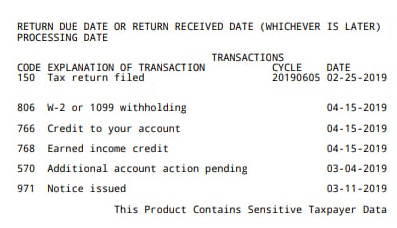
Tax season can often bring confusion and anxiety, especially when encountering unfamiliar codes on your tax transcript. Two common codes that taxpayers may come across are 570 and 971. In this blog post, we’ll explore the meaning of these codes, and their sequence, and discuss whether it’s better to receive a 570 followed by a 971 or vice versa. By understanding these codes, you’ll be better equipped to navigate any potential tax issues that may arise.
Understanding Tax Transcript Code 570 – Additional Account Action Pending: Code 570 refers to “Additional Account Action Pending” on your tax transcript. It typically appears when the IRS needs more time to review and process your tax return. This code may trigger a delay in the issuance of your tax refund or other actions related to your tax account. While it can be frustrating to see this code, it’s essential to remain patient and allow the IRS to complete their review.
Possible Reasons for Code 570:
- Identity Verification: The IRS may require additional information to confirm your identity and prevent fraudulent activity.
- Income Verification: If there are discrepancies or unusual income reported on your tax return, the IRS may need to verify the accuracy of the information.
- Reviewing Deductions or Credits: The IRS might be scrutinizing specific deductions or credits claimed on your return, such as the Earned Income Tax Credit (EITC) or the Child Tax Credit (CTC).
Understanding Tax Transcript Code 971 – Notice Issued: Code 971 indicates that the IRS has issued a notice or letter regarding your tax account. It is often accompanied by an explanation detailing the purpose of the notice. The notice could pertain to a variety of issues, such as changes to your tax return, adjustments to your refund amount, or requests for further documentation.
Possible Reasons for Code 971:
- Adjustment to Tax Liability: The IRS may have made changes to your tax return, resulting in an adjustment to your tax liability. This adjustment can be due to mathematical errors, unreported income, or disallowed deductions or credits.
- Request for Documentation: The notice may request additional documentation to support certain claims made on your tax return, such as proof of income or documentation for claimed deductions or credits.
- Audit Notification: In some cases, Code 971 can indicate that your tax return has been selected for an audit. An audit is a comprehensive review of your tax return to ensure its accuracy and compliance with tax laws.
Sequence: Code 570 vs. Code 971 When it comes to the sequence of receiving these codes, there isn’t a definitive “better” or “worse” order. The appearance of Code 570 before Code 971 or vice versa does not necessarily indicate the severity or outcome of the situation. The order of these codes may simply reflect the IRS’s internal processing and the specific actions taken on your tax account.
570 followed by 971: Receiving Code 570 first indicates that the IRS is reviewing your return, and additional action is pending. Once the review is complete, if any adjustments are necessary, Code 971 will appear, accompanied by a notice explaining the changes made. This sequence allows for the initial review and resolution of any discrepancies before issuing a notice.
971 followed by 570: In this sequence, Code 971 appears first, indicating that the IRS has issued a notice regarding your return. The notice will contain information about any adjustments made and may require a response or further action. After addressing the notice, if additional action is needed, Code 570 may follow. This sequence can lead to a more immediate notice of adjustments, potentially expediting the resolution process.
What to Do If You Receive These Codes:
- Read the Notice Carefully: If you receive Code 971, make sure to read the accompanying notice thoroughly. It will provide crucial information regarding the IRS’s actions and any necessary steps you need to take.
- Gather Supporting Documents: If the notice requests additional documentation, gather all relevant records and prepare a response that addresses the IRS’s concerns.
- Seek Professional Help: If you’re uncertain about how to proceed or require assistance in responding to the notice, consider consulting a tax professional who can guide you through the process.
Tax transcript codes 570 and 971 are significant indicators of the IRS’s actions regarding your tax return. Code 570 suggests that additional review or action is pending, while Code 971 signifies that a notice has been issued, outlining any adjustments made. While neither sequence is inherently better, understanding the implications of each can help you navigate the process and respond appropriately. If you receive either of these codes on your tax transcript, it is essential to carefully review any accompanying notices and take the necessary steps to ensure compliance with IRS requirements.

